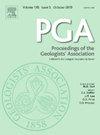摩洛哥西梅塞塔Senhaja盆地构造-沉积演化及其对认识晚瓦里斯坎构造过程的意义
IF 1.3
4区 地球科学
Q2 Earth and Planetary Sciences
引用次数: 0
摘要
在瓦里斯坎造山运动的最后阶段,一系列山间盆地沿着今天非洲的西北边缘发育,主要在西部(摩洛哥)梅塞塔地区。其中,位于Jebilet地块东部的Senhaja盆地在解释这些盆地的历时演化中起着关键作用。虽然传统上被认为是在类似的地球动力学条件下同步形成的,但最近的证据表明,这是一种更复杂和历时性的发展。森哈嘉盆地沉积环境以河流体系为主,其沉积相类型多样,近端为冲积扇,远端为湖相沉积。冲积扇砾石是森哈加盆地内沉积最粗糙的物质。沉积学和构造资料的综合分析支持了Senhaja盆地是一个响应NE-SW挤压形成的拉分盆地,伴随着局部的NW-SE伸展。与摩洛哥其他晚古生代盆地的对比分析表明,摩洛哥存在两代不同的盆地,它们在不同的构造制度下(从挤压到伸展)历时演化,同时在沉积充填方面表现出相似性。这些发现有助于对摩洛哥梅塞塔晚造山盆地的地球动力学演化及其对晚瓦里斯坎构造重组的启示进行更广泛的讨论。本文章由计算机程序翻译,如有差异,请以英文原文为准。
Tectono-sedimentary evolution of the Senhaja Basin (Western Meseta, Morocco) and its implication for understanding the late Variscan tectonic processes
During the final stage of the Variscan Orogeny, a series of intermontane basins developed along the present-day northwestern margin of Africa, predominantly within the Western (Moroccan) Meseta. Among them, the Senhaja Basin, located in the eastern Jebilet Massif, plays a key role in interpreting diachronous evolution of those basins. Whilst traditionally considered to have formed synchronously under similar geodynamic conditions, recent evidence suggests a more complex and diachronous development.
The depositional environment of the Senhaja Basin is dominated by a fluvial system, characterized by a diversity of facies ranging from the alluvial fans in its proximal part to lacustrine deposits in its distal part. The alluvial-fan gravels feature the coarsest material deposited within the Senhaja Basin.
Integration of sedimentological and structural data supports the interpretation of the Senhaja Basin as a pull-apart basin formed in response to NE–SW compression, accompanied by localized NW–SE extension. Comparative analysis with other Late Paleozoic basins in Morocco reveals the existence of two distinct generations of basins that evolved diachronously under varying tectonic regimes–ranging from compressional to extensional settings–whilst exhibiting similarities in sedimentary infill. These findings contribute to the broader discussion on the geodynamic evolution of late orogenic basins in the Moroccan Meseta and their implications for Late-Variscan tectonic reorganization.
求助全文
通过发布文献求助,成功后即可免费获取论文全文。
去求助
来源期刊
CiteScore
2.70
自引率
8.30%
发文量
54
审稿时长
6-12 weeks
期刊介绍:
The Proceedings of the Geologists'' Association is an international geoscience journal that was founded in 1859 and publishes research and review papers on all aspects of Earth Science. In particular, papers will focus on the geology of northwestern Europe and the Mediterranean, including both the onshore and offshore record. Following a long tradition, the PGA will focus on: i) a range of article types (see below) on topics of wide relevance to Earth Sciences ii) papers on aspects of Earth Science that have societal relevance including geoconservation and Earth management, iii) papers on palaeoenvironments and palaeontology of the Mesozoic and Cenozoic, iv) papers on aspects of Quaternary geology and climate change, and v) papers on the history of geology with particular reference to individuals that have shaped the subject. These topics will also steer the content of the themes of the Special Issues that are published in the PGA.

 求助内容:
求助内容: 应助结果提醒方式:
应助结果提醒方式:


